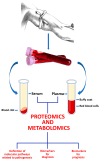The Impact of Serum/Plasma Proteomics on SARS-CoV-2 Diagnosis and Prognosis
- PMID: 39201322
- PMCID: PMC11354567
- DOI: 10.3390/ijms25168633
The Impact of Serum/Plasma Proteomics on SARS-CoV-2 Diagnosis and Prognosis
Abstract
While COVID-19's urgency has diminished since its emergence in late 2019, it remains a significant public health challenge. Recent research reveals that the molecular intricacies of this virus are far more complex than initially understood, with numerous post-translational modifications leading to diverse proteoforms and viral particle heterogeneity. Mass spectrometry-based proteomics of patient serum/plasma emerges as a promising complementary approach to traditional diagnostic methods, offering insights into SARS-CoV-2 protein dynamics and enhancing understanding of the disease and its long-term consequences. This article highlights key findings from three years of pandemic-era proteomics research. It delves into biomarker discovery, diagnostic advancements, and drug development efforts aimed at monitoring COVID-19 onset and progression and exploring treatment options. Additionally, it examines global protein abundance and post-translational modification profiling to elucidate signaling pathway alterations and protein-protein interactions during infection. Finally, it explores the potential of emerging multi-omics analytic strategies in combatting SARS-CoV-2.
Keywords: COVID-19; LC-MS; multi-omics; plasma; proteomics; serum.
Conflict of interest statement
The authors declare no conflicts of interest.
Figures
Similar articles
-
Proteomic Approaches to Study SARS-CoV-2 Biology and COVID-19 Pathology.J Proteome Res. 2021 Feb 5;20(2):1133-1152. doi: 10.1021/acs.jproteome.0c00764. Epub 2021 Jan 19. J Proteome Res. 2021. PMID: 33464917 Free PMC article.
-
Open Science Resources for the Mass Spectrometry-Based Analysis of SARS-CoV-2.J Proteome Res. 2021 Mar 5;20(3):1464-1475. doi: 10.1021/acs.jproteome.0c00929. Epub 2021 Feb 19. J Proteome Res. 2021. PMID: 33605735 Review.
-
Proteomics-Based Insights Into the SARS-CoV-2-Mediated COVID-19 Pandemic: A Review of the First Year of Research.Mol Cell Proteomics. 2021;20:100103. doi: 10.1016/j.mcpro.2021.100103. Epub 2021 Jun 4. Mol Cell Proteomics. 2021. PMID: 34089862 Free PMC article. Review.
-
Proteomics in the COVID-19 Battlefield: First Semester Check-Up.Proteomics. 2021 Jan;21(1):e2000198. doi: 10.1002/pmic.202000198. Epub 2020 Dec 2. Proteomics. 2021. PMID: 33236484 Free PMC article. Review.
-
Blood proteomics of COVID-19 infection: An update.Clin Chim Acta. 2024 Aug 15;562:119881. doi: 10.1016/j.cca.2024.119881. Epub 2024 Jul 19. Clin Chim Acta. 2024. PMID: 39033952 Review.
References
Publication types
MeSH terms
Substances
Grants and funding
LinkOut - more resources
Full Text Sources
Medical
Miscellaneous


